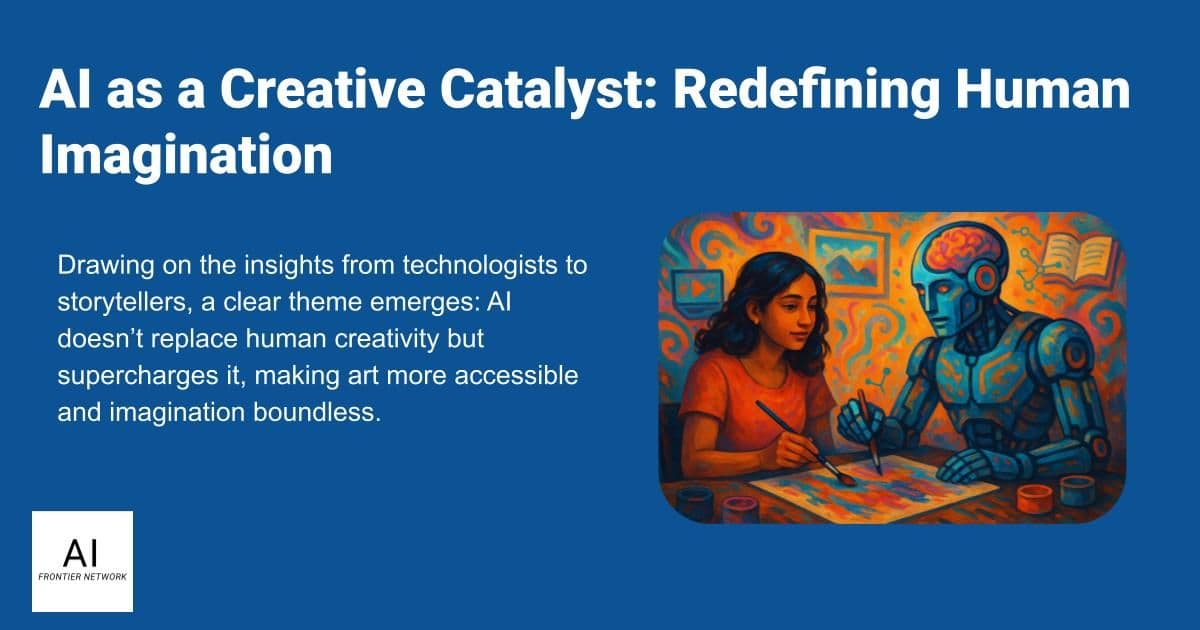In 2025, artificial intelligence is no longer just a tool for crunching numbers or automating tasks; it’s a dynamic partner in the creative process. From crafting short-form videos to blending art with science, AI is transforming how we dream, collaborate, and share stories. Drawing on the insights of our thought leaders, from technologists to storytellers, a clear theme emerges: AI doesn’t replace human creativity but supercharges it, making art more accessible and imagination boundless. This article weaves their perspectives into a vision of how AI is reshaping creativity, with clear takeaways on its role as a collaborative force.
Opening Creativity to Everyone
AI is tearing down barriers, letting more people create in ways once reserved for experts. Amar Chheda points to AI and virtual reality helping mural artists project sketches onto towering buildings, making grand-scale art practical. He also notes AI’s role in crafting books for those with reading or hearing challenges, expanding who can enjoy stories. Jason S. echoes this, calling AI a “creative accelerator” that lets new artists experiment, connect with communities, and collaborate without hefty budgets.
This accessibility isn’t just about tools; it’s about simplifying the technical side. Sudheer A. compares AI’s role to scaling apps in DevOps: it streamlines the process so anyone can express ideas without mastering every skill. Preetham Kaukuntla adds that this opens storytelling to new voices, letting creators “reach people more deeply” by removing obstacles like cost or expertise.
Boosting Imagination with a Digital Partner
AI isn’t here to steal the spotlight; it’s a collaborator that enhances what humans do best. Ganesh Kumar Suresh captures this, calling AI “the brush, not the artist; the amplifier, not the storyteller.” Jatinder Singh highlights tools like Runway’s Gen-2, which let creators test bold styles or concepts that once demanded big budgets. Dr. Anuradha Rao sees AI aiding scriptwriters by brainstorming plots or tweaking dialogue, speeding up work while keeping the creator’s voice intact.
In short-form video, AI’s impact shines. Rajesh Sura explains how it speeds up idea generation, editing, and tailoring content for different platforms. Nivedan S. notes that AI can handle scripting to voiceovers, letting creators “ideate, test, and publish in hours, not days.” But Sanjay Mood reminds us that storytelling’s heart stays human: AI can suggest ideas, but only people bring the emotional spark.
Rethinking What Creativity Means
AI is flipping the script on creativity, moving it from lone genius to team effort. Nivedan S. argues that creativity now involves designing workflows and prompts, focusing on problem-solving over pure originality. Paras Doshi points to AlphaGo’s groundbreaking moves in Go, showing AI can leap beyond what humans have done. But he stresses that diverse voices—artists, historians, everyday people—must shape what AI learns to avoid recycling old ideas.
This teamwork goes global. Devendra Singh Parmar describes AI enabling creators worldwide to collaborate in real time, syncing filmmakers in Mumbai with sound designers in Berlin. Hemlatha Kaur Saran sees AI connecting fields like biology and architecture, sparking hybrid art forms born from data. Creativity is becoming a shared, boundary-crossing pursuit, with AI as the glue.
Stretching the Creative Horizon
AI doesn’t just improve old methods; it opens new doors. Hina Gandhi imagines AI as a set designer, crafting photorealistic film environments from a director’s script in minutes. Balakrishna Sudabathula calls AI a “brainstorming partner that never tires,” churning out ideas for humans to refine. Nikhil Kassetty sums it up: “the canvas just got bigger,” making creativity more fluid and experimental.
For pros, AI saves time on grunt work. Jason S. notes it handles tasks like making captions or promo materials, freeing creators for deeper work. Amar Chheda finds a playful angle, suggesting that tweaking AI settings, like a language model’s temperature, can lead to surprising creative twists. This freedom to play fuels bold ideas.
Keeping It Human: Authenticity and Values
As AI redefines creativity, the human touch stays vital. Preetham Kaukuntla stresses that connection, emotion, and meaning come from people, not machines. Nikhil Kassetty urges weaving ethics and authenticity into AI’s role to keep creations genuine. Samarth Neeraw sees this as a dance between “silicon and soul,” balancing tech with humanity.
In short-form video, Jatinder Singh and Ganesh Kumar Suresh emphasize that AI’s speed mustn’t drown out authenticity; creators steer the vision. Sanjay Mood drives this home: human curiosity fuels creativity, and no tool can replace that fire.
A New Creative Frontier
These expert voices show AI as a spark for creativity, not a rival. It opens doors, boosts imagination, redefines artistry, and expands what’s possible, all while keeping humans at the helm. The future hinges on this partnership, blending tech’s power with human heart to tell stories that resonate.
But we must stay mindful. AI’s strength depends on how we use it, prioritizing ethics and authenticity. By embracing this collaboration, we can make creativity more inclusive, inventive, and alive than ever.













